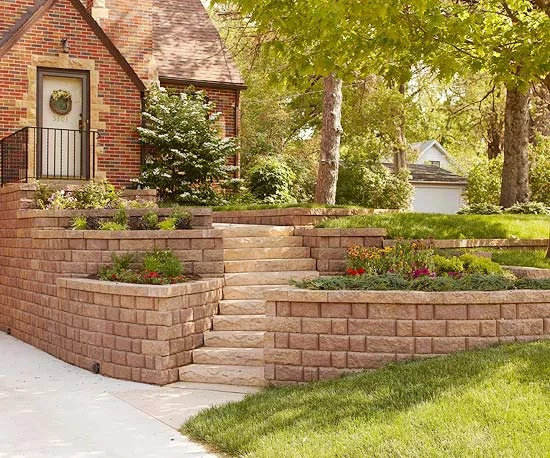Gardeners use landscape retaining walls to fight gravity, often built to hold back part of a yard that would otherwise lead to a landslide. They can also step up an especially steep slope, cut down on erosion, and carve out distinct outdoor rooms at different elevations.
But landscape retaining walls must be correctly constructed and maintained to do their job and stay stable. That includes building a solid base, adding enough tilt to the back (called battering), and including drains to keep water from damming up behind them. The soil constantly pushing on landscape retaining walls requires regular maintenance and occasional repairs. Here's how to build yours and keep it in the best shape possible.
How to Build a Landscape Retaining Wall
Dig a Trench and Add Sand
Start by creating a path for your landscape retaining wall using wood stakes and a mason's line, then dig away excess soil. (The first course, or line, of the block will need to nest in a trench, sitting at least 2 inches below the soil in front.) Line the back face and inside of the trench with landscape fabric, then add a 1-inch-deep layer of sand for bedding.
Install Drainage
To ensure good drainage, install a perforated drainpipe behind the first course of the landscape wall, using soil to create grading and a slight incline. Make sure to fit the open ends of the pipe run with grate inserts to prevent clogging. Pull the landscape fabric down to cover the drainage pipe, then add a 3-inch layer of crushed rock.
Lay Down the First Line
Set the first base block into the sand and tamp with a mallet. The blocks should tilt back slightly, creating a slight incline and forcing the wall to lean into the hill. Nestle the remaining base blocks into the sand; align them along the top and back surfaces, checking with a straightedge and tamping each block with a mallet. Complete the block pattern until you have a flat first course; apply cap units with construction adhesive, cut away excess landscape fabric, and backfill the hillside behind the wall. At the front of the wall, add fill dirt to cover at least half of the base course blocks.
Choose Landscaping Wisely
Is planting on top of a landscape retaining wall safe? Yes—as long as you choose your greenery wisely. Plants will help integrate the wall into the landscape, but you have to select species that won't disrupt the structure with their roots. Plant flowers and groundcovers closest to the wall while placing small shrubs at least 3 feet away. Large shrubs and small trees should be at least 6 feet from the wall and large trees at least 15 feet.
The Most Common Problems for Landscape Retaining Walls
The Problem: Improper Drainage
Improper drainage is a primary culprit behind retaining wall failure. Why? If water isn't being diverted, moisture and waterlogged soil build up behind the wall, compromising its integrity. Correctly installing piping is critical to the success of your landscape wall.
Even if your piping is doing its job, you still need to maintain it. Some walls include weep holes along the base, allowing water to run through the structure. Regularly clean these openings with a piece of wire or a screwdriver to ensure they stay open. If there's a drainpipe behind your wall, check that the pipe isn't plugged during the rainy months.
The Problem: Tilted Walls
If a landscape retaining wall is leaning downhill instead of tilting back slightly, you know it's losing the battle with gravity, succumbing to the weight of the earth behind it. The same holds true if a section of the wall is bowing. Unfortunately, landscape walls can't be pushed back into proper alignment; they must be torn down and rebuilt.
The Problem: Loose Bricks or Rocks
Saturated soil can cause your landscape retaining wall to shift, breaking loose its bricks or rocks. Cracks may also form if the wall isn't built correctly or the mortar isn't prepared with the right consistency.
First, address any underlying drainage issues or structural problems. Then, tackle the loose material.
If it's a brick in a mortared wall breaking free, remove it and chip away the old mortar around it. Apply a layer of ready-mix mortar, available at home supply stores, to the bottom and ends of the brick, then slide the brick back into the opening. Add mortar to the top of the brick by pushing mortar from your trowel into the space with a jointing tool or the back of an old spoon. Scrape the excess mortar from the brick with a trowel, then clean the brick with a wet rag. Repair loose rocks in a mortared stone landscape wall in the same manner.
If it's a loose cap rock on a stone wall, chip off the old mortar, then set the cap rock in a new bed of mortar. Fill any gaps around the cap rock with mortar.




















